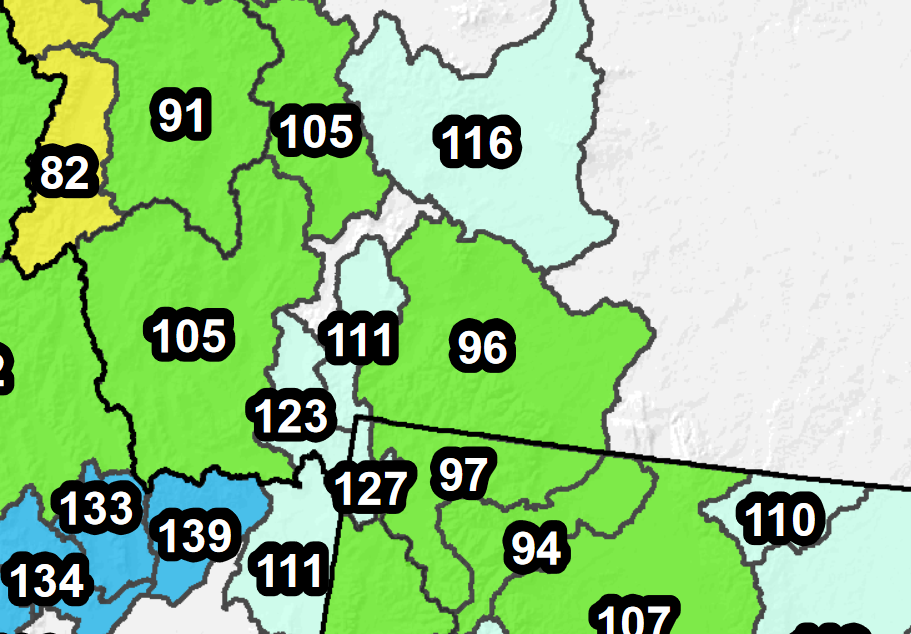Early February Snowpack Report
Posted on February 5th, 2023 in Season Forecasts, Weather & Water Conditions
This post is reprinted from our February 1 newsletter. Lots more there if you click!
Winter and spring snowpack and how this snow melts between late April and mid-June are the primary drivers for summer and early fall water conditions in our region (and most of the West). While there can be some surprises, like last year’s intense May and June snowfall followed by intense rain, which led to the June 2022 floods, we like to keep track of snowpack to help our clients start planning summer fishing trips. In general, we like snowpack to run about 110% of normal as of May 10 or so. This is enough extra moisture that it provides a cushion of cold water in late July and August to protect from summer heat waves, while still allowing for a near-normal end to runoff in the first week of July on our prime summer fisheries: the Yellowstone River System including its tributary basins in Yellowstone Park (Lamar and Gardner) and Montana (Boulder and Stillwater).
Our first update of the season is below. We’ll post further updates on our blog around twice a month.
 The Boulder River was the most consistent fishery in the area in early July last year.
The Boulder River was the most consistent fishery in the area in early July last year.
We enjoyed a very promising start to winter, with abundant snow and cold temperatures in November and early December. Bridger Bowl ski area opened on time for the first time since 2019 (December 9), and only low staffing kept them from opening in mid-November for the first time in decades. Unfortunately, the snow stopped around Christmas and most of January was exceptionally dry. Only an immense snow storm last week saved January from perhaps being record-dry. Except for an early January blip, temperatures have generally been normal to cold, which is ideal. This puts whatever snow that does fall into a blast freezer and makes for slow melting come May and June, allowing more of the snow to enter the ground water. After the good start, poor late December and most of January, and big storm last week, snowpack in our operations area now ranges from 96% of normal to 127% if normal. These numbers refer to average snowpack for the date, not total snowfall for the entire year.

The Madison Basin in YNP is highest, at 127% of normal. This is a nice change of pace which–if it continues–might keep the Firehole and Gibbon Rivers in Yellowstone Park fishing well through June or into July this year. The Yellowstone Basins in Montana and YNP are lowest, at 96% and 97%. Other basins range between the two extremes, but generally run slightly above 100% of normal for the date. As the numbers suggest, we’re generally doing pretty good so far, though we would like the numbers in the Yellowstone Basin to rise somewhat.
The short-term outlooks until roughly mid-February don’t look promising for much more snowfall, but the one-month outlook for February and three-month outlook for February through April look promising.

It’s still early to be making specific predictions on when various fisheries are going to be most productive, but I still try to stare into a crystal ball. With current conditions and predictions for the remainder of winter, I now expect the most consistent fishing on our usual high season fisheries to take place in the latter half of July and first half of August.
Late August conditions will be fine if snowpack remains near to above normal, and as usual September and October fishing depends more on day-to-day weather than it does on snowpack. Extreme drought like we saw in 2021 is not likely. As such, it’s unlikely the Yellowstone system will fish at all between the onset of runoff sometime in early May and at least June 20, with a day or two here and there on the Boulder and Gardner Rivers the only exceptions. The Madison River in Montana, Madison System in YNP, and area lakes will therefore be our primary fisheries in May and June.
If snowpack falls off from current numbers, it is still possible that somewhat-low snowpack will lead to early July being better in the Yellowstone System than late July and early August. That said, overall conditions look at least “within the normal range” so far, which should mean at least decent fishing throughout the high season.
The overall picture presented above will get clearer and clearer as winter and spring progress. Look for another update in mid-February.